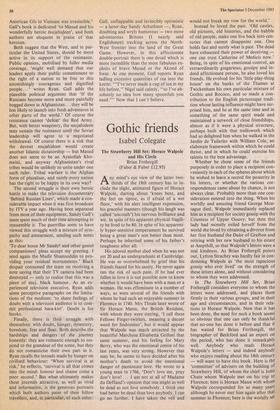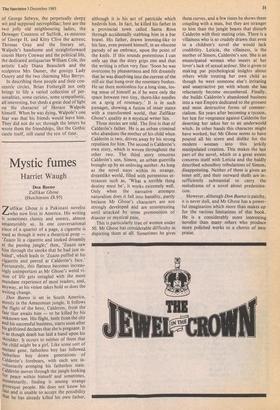Gothic friends
Isabel Colegate
The Strawberry Hill Set: Horace Walpole and His Circle Brian Fothergill (Faber & Faber £12.95)
Any mind's eye view of the latter two- thirds of the 18th century has to in- clude the slight, animated figure of Horace Walpole, darting about 'knees bent, and, the feet on tiptoe, as if afraid of a wet floor,' with his alert intelligent expression, his graceful manners (though his laugh was called 'uncouth') his nervous brilliance and wit. In spite of his apparent physical fragili- ty he lived to be 80. In spite of his apparent- ly hyper-sensitive temperament he survived being a great man's son better than most. Perhaps he inherited some of his father's toughness after all.
His adored mother died when he was not yet 20 and an undergraduate at Cambridge. He was so overwhelmed by grief that his friends feared for his sanity. He never again ran the risk of such pain. If he had ever fallen in love it is not possible now to know whether it would have been with a man or a woman. He was effeminate in a number of ways, as were several of the friends with whom he had such an enjoyable summer in Florence in 1740. Mrs Thrale later wrote of Sir Horace Mann, the British Resident, with whom they were staying, 'I call these Fellows Finger-twirlers, meaning a decent word for Sodomites', but it would appear that Walpole was much attracted by the beautiful Marchesa Elisabetta Grifoni that same summer, and his feeling for Mary Berry, who was the emotional centre of his last years, was very strong. However that may be, he seems to have decided after his mother's death to avoid the emotional danger of passionate love. He wrote to a young man in 1766, 'Don't love me, pray don't love!... I am not at all of Madame du Deffand's opinion that one might as well be dead as not love somebody. I think one had better be dead than love anybody. I can go no further. I have taken the veil and would not break my vow for the world.'
Instead he loved the past. 'Old castles, old pictures, old histories, and the babble of old people, make one live back into cen- turies that cannot disappoint one. One holds fast and surely what is past. The dead have exhausted their power of deceiving one can trust Catherine of Medicis now.' Being, in spite of his emotional control, an extraordinarily gregarious, gossipy and in- deed affectionate person, he also loved his friends. He evolved for his 'little play-thing house' on the banks of the Thames at Twickenham his own particular mixture of Gothic and Rococo, and so made a con- tribution to the English picturesque tradi- tion whose lasting influence might have sur- prised him, and he at the same time and in something of the same spirit made and maintained a network of close friendships, almost as if it were a physical structure, perhaps built with that trelliswork which had so delighted him when he walked in the Jardin de Tuileries with William Cole, an elaborate framework within which he could thrive, and in which he could exercise his talents to the best advantage.
Whether he chose some of the friends purposely in order to place a recipient con- veniently in each of the spheres about which he wished to leave a record for posterity in his letters, or whether the various cor- respondences came about by chance, is not always clear. Probably more than one con- sideration entered into the thing. When his worldly and amusing friend George Mon- tague died, Walpole immediately replaced him as a recipient for society gossip with the Countess of Upper Ossory; but then this lady had recently exiled herself from the world she loved by obtaining a divorce from her first husband the Duke of Grafton and retiring with her new husband to his estate at Ampthill, so that Walpole's letters were a real kindness. As Brian Fothergill points out, Lytton Strachey was hardly fair in con- demning Walpole as 'the most rapacious gossip who ever lived' on the strength of these letters alone, and without considering to whom they were addressed.
In The Strawberry Hill Set, Brian Fothergill considers everyone to whom the letters were addressed, and places them firmly in their various groups, and in their age and circumstances, and in their rela- tions to Horace Walpole. Now that it has been done, the need for such a book seems so obvious that one can only be thankful that no-one has done it before and that it has waited for Brian Forthergill, the biographer of Beck ford and an expert on the period, who has done it remarkably well. Anybody who reads Horace Walpole's letters — and indeed anybody who enjoys reading about the 18th century — will want to have this book. Here is the `committee' of advisers on the building of Strawberry Hill, of whom the chief is John Chute whom Walpole met on his trip to Florence; here is Horace Mann with whom Walpole corresponded for so many years although he never met him again after that summer in Florence; here is the worldly set
of George Selwyn, the perpetually sleepy
wit two supposed necrophiliac; here are the two jolly old neighbouring ladies, the Dowager Countess of Suffolk, ex-mistress of George 11, and Kitty Clive the actress; Thomas Gray and the literary set, Walpole's handsome and straightforward cousin Harry Conway and the political life, the dedicated antiquarian William Cole, the artistic Lady Diana Beauclerk and the sculptress Mrs Darner, the gossipy Lady Ossory and the two charming Miss Berrys.
In describing these people and their con- centric circles, Brian Fothergill not only brings to life a varied collection of per- sonalities, some curious, some sympathetic, all interesting, but sheds a great deal of light on the character of Horace Walpole himself. When he was dying, Walpole's one fear was that his friends would leave him. They did not do so; through the letters he wrote them the friendships, like the Gothic castle itself, still stand the test of time.















































 Previous page
Previous page